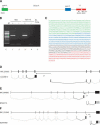Gene-breaking: a new paradigm for human retrotransposon-mediated gene evolution
- PMID: 16024818
- PMCID: PMC1182219
- DOI: 10.1101/gr.3688905
Gene-breaking: a new paradigm for human retrotransposon-mediated gene evolution
Abstract
The L1 retrotransposon is the most highly successful autonomous retrotransposon in mammals. This prolific genome parasite may on occasion benefit its host through genome rearrangements or adjustments of host gene expression. In examining possible effects of L1 elements on host gene expression, we investigated whether a full-length L1 element inserted in the antisense orientation into an intron of a cellular gene may actually split the gene's transcript into two smaller transcripts: (1) a transcript containing the upstream exons and terminating in the major antisense polyadenylation site (MAPS) of the L1, and (2) a transcript derived from the L1 antisense promoter (ASP) that includes the downstream exons of the gene. Bioinformatic analysis and experimental follow-up provide evidence for this L1 "gene-breaking" hypothesis. We identified three human genes apparently "broken" by L1 elements, as well as 12 more candidate genes. Most of the inserted L1 elements in our 15 candidate genes predate the human/chimp divergence. If indeed split, the transcripts of these genes may in at least one case encode potentially interacting proteins, and in another case may encode novel proteins. Gene-breaking represents a new mechanism through which L1 elements remodel mammalian genomes.
Figures





Similar articles
-
Many human genes are transcribed from the antisense promoter of L1 retrotransposon.Genomics. 2002 May;79(5):628-34. doi: 10.1006/geno.2002.6758. Genomics. 2002. PMID: 11991712
-
Genome-wide characterization of human L1 antisense promoter-driven transcripts.BMC Genomics. 2016 Jun 14;17:463. doi: 10.1186/s12864-016-2800-5. BMC Genomics. 2016. PMID: 27301971 Free PMC article.
-
Identification of human-specific transcript variants induced by DNA insertions in the human genome.Bioinformatics. 2011 Jan 1;27(1):14-21. doi: 10.1093/bioinformatics/btq612. Epub 2010 Oct 29. Bioinformatics. 2011. PMID: 21037245
-
LINE-1 retrotransposons: modulators of quantity and quality of mammalian gene expression?Bioessays. 2005 Aug;27(8):775-84. doi: 10.1002/bies.20257. Bioessays. 2005. PMID: 16015595 Review.
-
Retroelements in human disease.Gene. 2013 Apr 15;518(2):231-41. doi: 10.1016/j.gene.2013.01.008. Epub 2013 Jan 17. Gene. 2013. PMID: 23333607 Review.
Cited by
-
Mobile elements contribute to the uniqueness of human genome with 15,000 human-specific insertions and 14 Mbp sequence increase.DNA Res. 2018 Oct 1;25(5):521-533. doi: 10.1093/dnares/dsy022. DNA Res. 2018. PMID: 30052927 Free PMC article.
-
LINE-1 elements in structural variation and disease.Annu Rev Genomics Hum Genet. 2011;12:187-215. doi: 10.1146/annurev-genom-082509-141802. Annu Rev Genomics Hum Genet. 2011. PMID: 21801021 Free PMC article. Review.
-
Transcription coupled repair and biased insertion of human retrotransposon L1 in transcribed genes.Mob DNA. 2017 Dec 6;8:18. doi: 10.1186/s13100-017-0100-5. eCollection 2017. Mob DNA. 2017. PMID: 29225704 Free PMC article.
-
Extensive variation between inbred mouse strains due to endogenous L1 retrotransposition.Genome Res. 2008 Jun;18(6):869-80. doi: 10.1101/gr.075770.107. Epub 2008 Apr 1. Genome Res. 2008. PMID: 18381897 Free PMC article.
-
The impact of retrotransposons on human genome evolution.Nat Rev Genet. 2009 Oct;10(10):691-703. doi: 10.1038/nrg2640. Nat Rev Genet. 2009. PMID: 19763152 Free PMC article. Review.
References
Publication types
MeSH terms
Substances
Grants and funding
LinkOut - more resources
Full Text Sources
Miscellaneous
